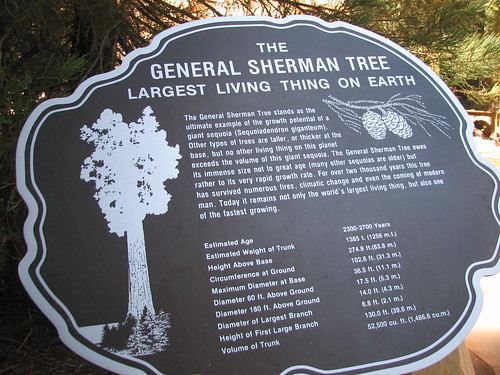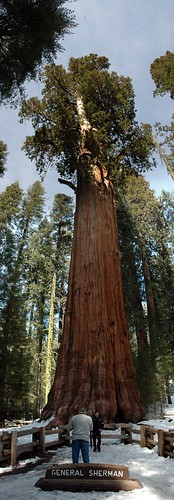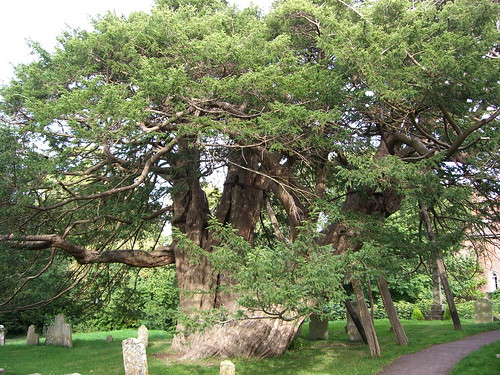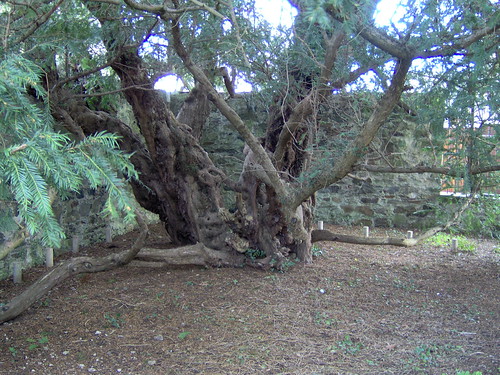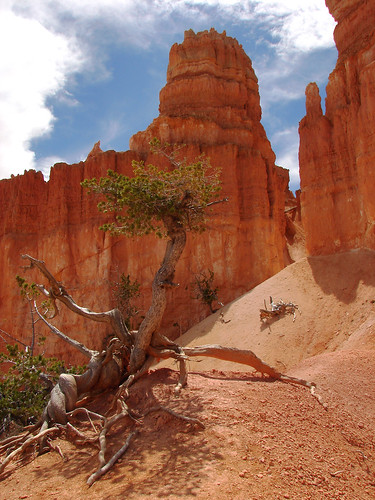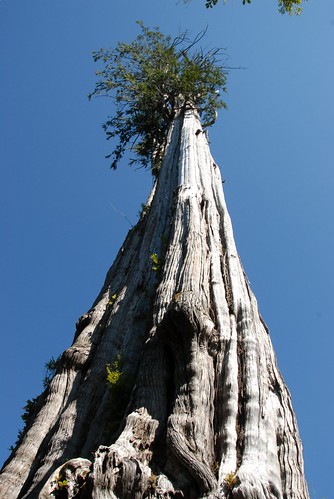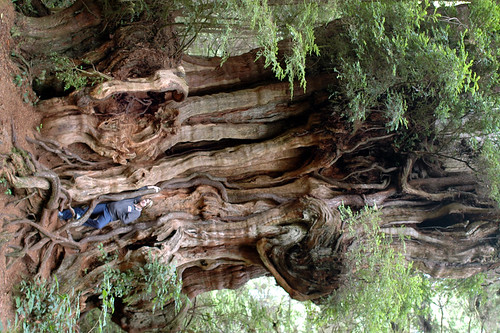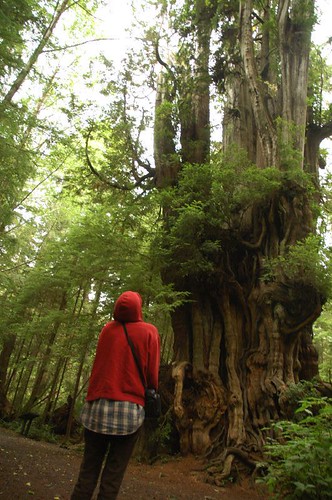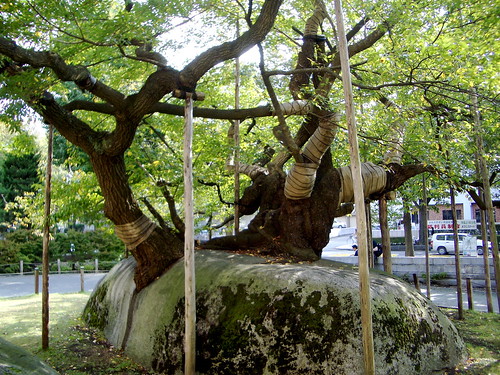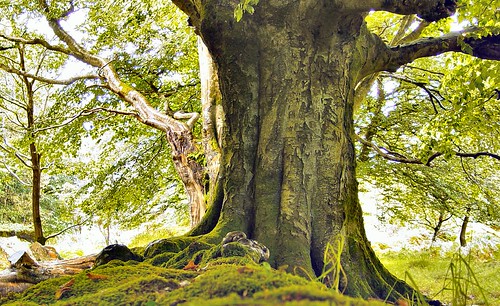Researchers in Sweden have discovered group of old Spruce trees in dalarna with an 5,000-8,000 year old root system (clonal colony). While the individual Spruce trees may only be only several hundred years old the root system they are "sprouting" up from lives on. Original story found at...
http://www.thelocal.se/11054.html
Old Spruce trees in Sweden
Pando tree - Aspen clonal colony
 The Pando tree is a "clonal colony" which means that this whole grove is one living organism that sends up multiple "stems". Each of what we would consider one "tree" is just a part of this giant living organism. These individual "stems" sprout grow to maturity and eventually age and die and fall over but the organism that they are a part of lives on. The largest known clonal colony is this forest of quacking aspens in Colorado that is estimated to have 40,000 stems and to be as old as 80,000 years.
The Pando tree is a "clonal colony" which means that this whole grove is one living organism that sends up multiple "stems". Each of what we would consider one "tree" is just a part of this giant living organism. These individual "stems" sprout grow to maturity and eventually age and die and fall over but the organism that they are a part of lives on. The largest known clonal colony is this forest of quacking aspens in Colorado that is estimated to have 40,000 stems and to be as old as 80,000 years.
Largest Baobab in the world
"Big Baobab Tree (Adansonia digitata): This giant and ancient baobab at the Sunland Nursery, between Duiwelskloof and Ga-Kgapane, is the biggest specimen in the world. It has a circumference of 46,8m and carbon dating has determined its age at an astronomical 6000 years." from http://www.places.co.za/html/tzaneen.html
"When baobabs become a thousand years old, they begin to hollow inside. In the Big Baobab this has resulted in wonderful caverns and caves, where the world famous Baobab Tree Bar and Wine Cellar now amaze visitors. The tree bar can accommodate more than 60 people!"
from http://www.bigbaobab.co.za/
see also...
http://arbresvenerables.free.fr/ArbresVenerables/South%20Africa.htm
Chapman´s Baobab - botswana
In Botswana´s Kalarari Desert near the Makgadikgadi Pans (once a very immense inland lake in
General Sherman - largest tree in the world
The General Sherman Tree is the largest tree by volume in the world and one of the fastest growing. It belongs to the species Sequoiadendron giganteum.
This sign reads…
GENERAL SHERMAN TREE
LARGEST LIVING THING ON EARTH
“The General Sherman Tree stands as the ultimate example of the growth potential of a giant sequoia (Sequoiadendron giganteum). Other types of trees are taller, or thicker at the base, but not other living thing on this planet exceeds the volume of this giant sequoia. The General Sherman Tree owes its immense size not to great age (many other sequoias are older) but rather to its very rapid growth rate. For over two thousand years this tree has survived numerous fires, climatic change and even the coming of modern man. Today it remains not only the world’s largest living thing, but also one of the fastest growing.”
Estimated Age 2,300 – 2,700 years
Estimated Wight of trunk 1385 t. (1256 m.t. )
Height Above Base 274.9 ft (83.8 meters)
Circumference as Ground 102.6 ft. (31.3 meters)
Maximum diameter at base 36.5 ft. (11.1 meters)
Diameter 60 ft. above ground 17.5 ft (5.3 meters)
Diameter 180 ft. above ground 14.0 ft. (4.3 meters)
Diameter of largest branch 6.8 ft. (2.1 meters)
Height of First large branch 130 ft. (39.6 meters)
Volume of trunk 52,500 cu. ft. (1,486.6 cu.m.)
Pamplemousses Botanical Garden tree
This large tree, estimated to be about 300 years old is located in the “Sir Seewoosagur Ramgoolam Botanical Garden” more commonly known as the Pamplemousses botanical garden. The garden is a popular attraction near Port Louis in Mauritius It is reputed to be the oldest botanical garden in the Southern Hemisphere. I do not know what kind of tree this is. If you know please leave a comment.
Ancient olive tree - garden of Gethsemane
These are perhaps the world´s most famous Olive trees. The Garden of Gethsemane is located in Jerusalem at the base of the Mount of Olives. It was in this small grove of Olive trees that Jesus spent part of the night prior to his crucifixion. Gethsemane means "Olive press" in Hebrew.
Jomon Sugi tree - Largest Cedar in Japan
This large “Yakusugi Cedar” (Cryptomeria japonica) tree was located in 1996 and has since become quite famous. It is said to be the largest Cedar tree in Japan. It is 25 meters tall and estimated to be around 2,200 years old (some claim that it is much older). It is called “Jomon-sugi” (meaning Old Cedar) and is located in the Yakushima World Heritage Area.

Roots II, originally uploaded by antonioperezrio.es.
“In its vicinity, there remains a stump of which age is said to be oldest
by the islanders. They say the tree was cut in 1586 to be used for
construction of a big temple in Kyoto. The age of the tree when cut down
is estimated to be 3000 years.” from www.nyu.edu
Ancient yew - St. Mary & St. Peter, Wilmington
Have you ever noticed that there seems to be a connection between old Yew trees and churches in England? Well, here is another example of an old Yew tree in the church yard of St. Mary & St. Peter´s in Wilmington. The tree is estimated to be over 1,600 years old, which means that it predates the church by a good many years.
Old oak tree at Rufford Hall
This old oak tree in it full autumn colors is located at Rufford Hall in Nottinghamshire. It is an English Oak (also called Pedunculate Oak) which is the species Quercus robur.
Oldgrowth Juniper forest in SE Colorado
Located atop a mesa near the Purgatory river in SE Colorado there is a forest of old growth Juniper trees that are twisted and gnarled with age creating a beautiful and striking ecosystem.
Labels: America, Old, picturesque
Oldest tree in Europe - The Fortingall Yew
This Yew tree in Scotland is believed to be around 5000 years old. It is not only the oldest tree but also the oldest living thing in Europe. It stands now behind a protective wall in the cemetary of a church.
The sign below reads...
Rooted in History
"Before you stands Europe´s - and possibly even the world´s oldest living thing. Under the dark veil of needles are two relic trunks of a huge, ancient yew tree. Scholars believe the roots of this great survivor coil back some 5000 years. The markers show you the size fo the original evergreen giant in 1769 when it had a girth of over 56 feet (17m). Sadly, it attracted souvenir hunters who removed large sections. Children then lit fires inside the hollow trunk and funeral
processions passed through its midst. Eventually, this wall had to be built to stop the tree disappearing altogether."
From Here to Eternity
"Before the arrival of Christianity, the yew was known as the "tree of eternity", and it´s easy to see why. At about 500 years old - long after most other trees have died - the yew starts to grow again. This "otherworldly" power meant early peoples revered the yew, and the tree marked their places of worship. Little wonder then that when early Christianity came to Fortingall in the
7th century they decided to build their new church next to the anciant yew."
Bristlecone Pine in Bryce Canyon
Looking at the eroding rock and the long living Bristlecone Pine one has to wonder who will outlive the other. Bristlecones are known to live more than 4000 years in the right conditions. What will this canyon look like in another 1000 or so years? You can already see how much of the tree roots have been exposed by the eroding canyon. This image was taken along Peekaboo Loop Trail
Sabina of "El Hierro" Island
This ancient Phoenicean Juniper is a famous tree on the Spanish island of "El Hierro" (name means Iron). The word Sabina is Spanish for Juniper. This tree is the most well known of many Juniper trees on the island that have been deformed by the constant wind. According to the locals there used to be large numbers of Junipers on the Island but because their wood was prized for making tables, stools, torches etc they were cut down and used until only the most deformed ones were left. These were not cut because their shape made them not very usable.
Labels: bizzare, Canary Islands, Old, scenic, Spain
900 year old Pine tree in Italy
This 900 year old tree is a "Loricato" or "Bosnian Pine" (Pinus leucodermis) located in the Pollino National Park in Italy. This national park is the last reserve of this rare tree species. I believe that this particular tree is known localy as "il grande vicchio".
Labels: endangered, Europe, italy, Old, Pine
The Duncan Cedar
"In 1938 the Federal Government in Washington DC agreed, after a long bettering from conservationists, to carve out a national park 3000 miles away on the west side of the Olympic Peninsula in Washington State. This saved from the loggers four rain-swept river valleys, rich in old growth forests - the Bogachiel, the Hoh, the Queets, and the Quninalt. But, as so often happened in the Pacific north-west, on both sides of the Canadian-US border, the boundaries of the new park were deliberately designed to exclude much of the best old-growth forests.
The Nolan Creek cedar grew in the heart of an ancient forest west of the park. less than 30 years ago, loggers were licensed by the state to clear-fell the whole area. When the chainsaw reached this western read cedar (Thuja plicata) and people realized that it was the third largest red cedar in the world (it's 178 feet tall with a volume of 15,300 cubic feet) even the loggers' spirits failed. Generously they agreed to preserve this single tree - worth, they say, the huge sum of $25,000.
And there is stands today. If the loggers hoped the tree would show their hearts were in the right place, they knew little about trees. Of course the giant could not survive the fierce winds of the clearcut. First the mosses and lichens, then the tree itself, began to die. Now it is a bleached skeleton with few living branches. There is a message there, I am sure, that the public can not miss. How futile is it to make this mean sort of compromise, rather than saving the whole watershed . . . Imagine trying to preserve this king of the forest, when all his kingdom lies in ruin. Soon his bones, too, will lie at Nolan Creek."
-Thomas Pakenham
"Remarkable Trees of the World"
Large Old Cedar at Kalaloch, Washington
This very large gnarly, old Western Red Cedar is located near kalaloch, Washington in the Olympic National Forest. The tree is impresive both for its great size and for the "Ent" like look of its twisted and gnarled trunk.
This tree is known as the Kalaloch Cedar.
another view of this tree
The Kalaloch Cedar, just off Highway 101 in the Olympic National Park
A sign at this tree reads…
Big Cedar
“Western redcedar has been the art and sinew of coastal Indian village life. The trunk is house plank and ocean-going canoe; branches are harpoon line; outer bark is diaper and bandage; inner bark is basket, clothing and mattress. Tree size expresses climate – heavy annual rainfall, and the nourishing damp of ocean fog. In a scramble for growing space other tree species are using the cedar as a standing nurselog.”
another view
Hollow Tree in Stanley Park - Vancouver, BC
A sign by this tree reads…
“This now hollowed out stump with “nurse trees” growing from the crevices of its woody skeleton was once a thriving cedar tree. At one time its girth measured 18.3 meters (60 feet). In the early 1900´s this site was a very popular location for photographs either with horses & buggies backed into the hollow or those newfangled contraptions, automobiles!”
below is an old photograph of this same tree taken in 1897 by William Notman

Great Cedar Tree, originally uploaded by SqueakyMarmot.
**UPDATE - April 17, 2008**
I was able to visit this tree in March. The old hollow tree was damaged in a storm this last December and is hardly standing. It has a few cables keeping it from tipping over. The base has also deteriorated considerably making the hollowed out portion quite a bit smaller than in used to be. As of April 1st the Vancouver city council has voted to remove the old stump entirely. This tree has been in Stanley Park for about 1000 years.

The Rock Splitting Cherry Tree
It is quite amazing what tree roots can do. This 400 year old Cherry tree in Morioka, Japan is famous for the fact that it has split a large granite boulder in two with its roots.
Old tree near Glendalough - Ireland
If trees could talk this one would have a lot of tales to tell.
Tales of bandits waiting to ambush lone travelers.
Tales of lovers meeting secretly in the forest.
Tales of battles won and battles lost.
Tales of hunters tracking the golden Stag.
Oh, if only the trees could talk!





